This morning we left Fez behind and set off in a private bus (thank fuck for that – the original itinerary said we’d be on public transport!) for Chefchaouen. The private bus was so we could stop here and there and check out a few things on the way, have a picnic lunch somewhere and take our time… it’s not my preference to turn a 4 hour drive into a 6 hour one, but if it saves us from squishing in with 50 or more, and a driver who’s likely on his phone and smoking while whipping around the mountains on the local bus, then I’m down with that.
We had a few photo stops on the way, this is one of the water reservoir dams that feeds Fez. You can see the waterline is way down on ‘what it is supposed to be at this time of year’. 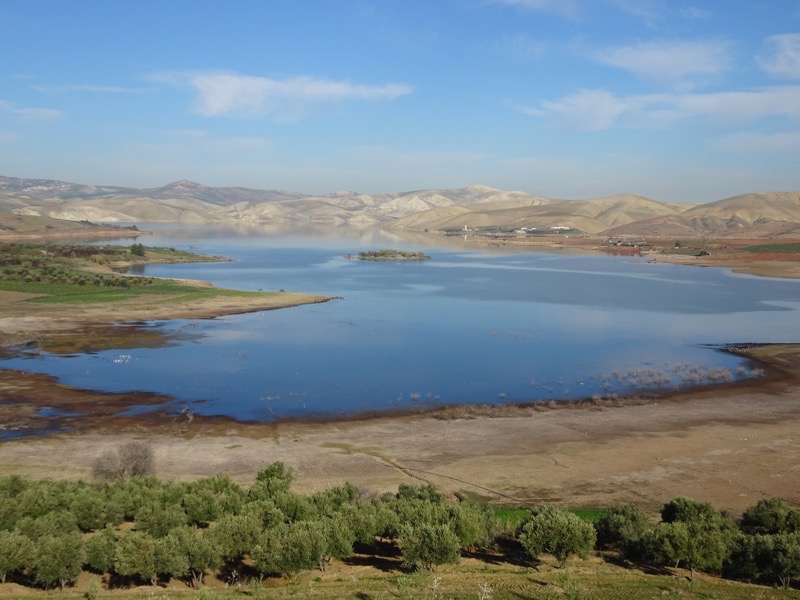 We also made a stop at an orange orchard so we could buy a few fresh oranges for our picnic. The oranges here are lovely, you can get large, cheap glasses of fresh orange juice in restaurants everywhere and the juice tastes slightly more like mandarins than the oranges at home.
We also made a stop at an orange orchard so we could buy a few fresh oranges for our picnic. The oranges here are lovely, you can get large, cheap glasses of fresh orange juice in restaurants everywhere and the juice tastes slightly more like mandarins than the oranges at home. 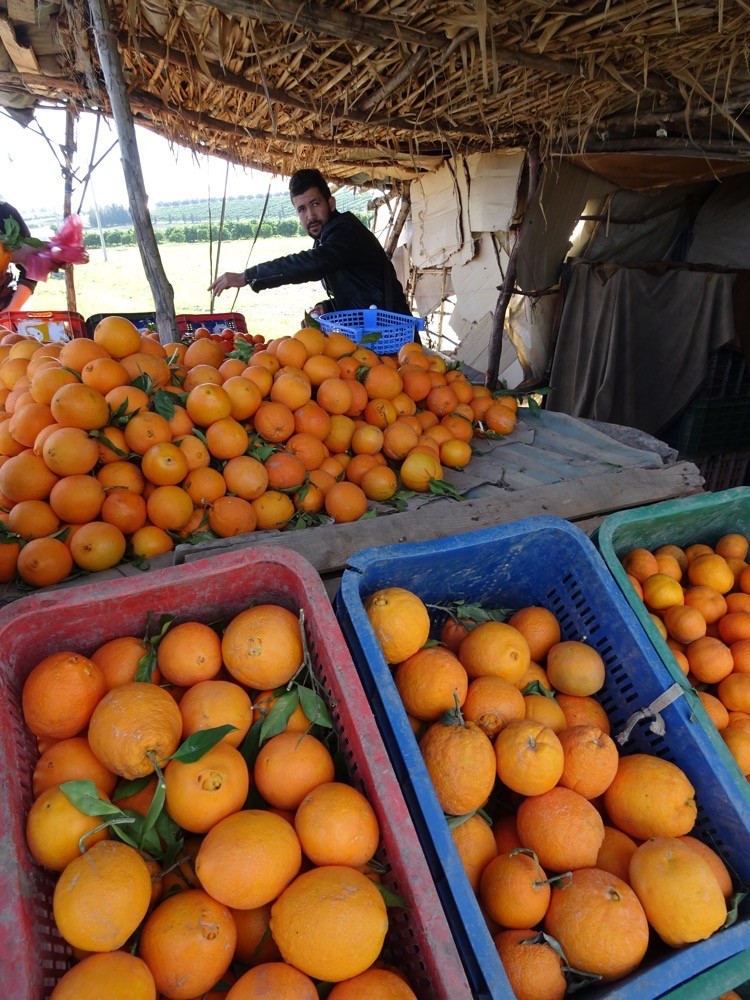 Everytime we get into the countryside, I can’t believe how green everything is…. the grass is lush and green, the trees are green, the stock looks fat and healthy… the drought at home is quickly brought into stark contrast.
Everytime we get into the countryside, I can’t believe how green everything is…. the grass is lush and green, the trees are green, the stock looks fat and healthy… the drought at home is quickly brought into stark contrast. Another stop we made was at an olive press co-op. Some of the smaller local farmers don’t have the expensive machinery required to press olives, so they bring their harvest here and their bags are numbered. They then wait their turn and put their olives through the press. The air felt thick and kinda slimy… the ground is literally dripping in olive oil.
Another stop we made was at an olive press co-op. Some of the smaller local farmers don’t have the expensive machinery required to press olives, so they bring their harvest here and their bags are numbered. They then wait their turn and put their olives through the press. The air felt thick and kinda slimy… the ground is literally dripping in olive oil.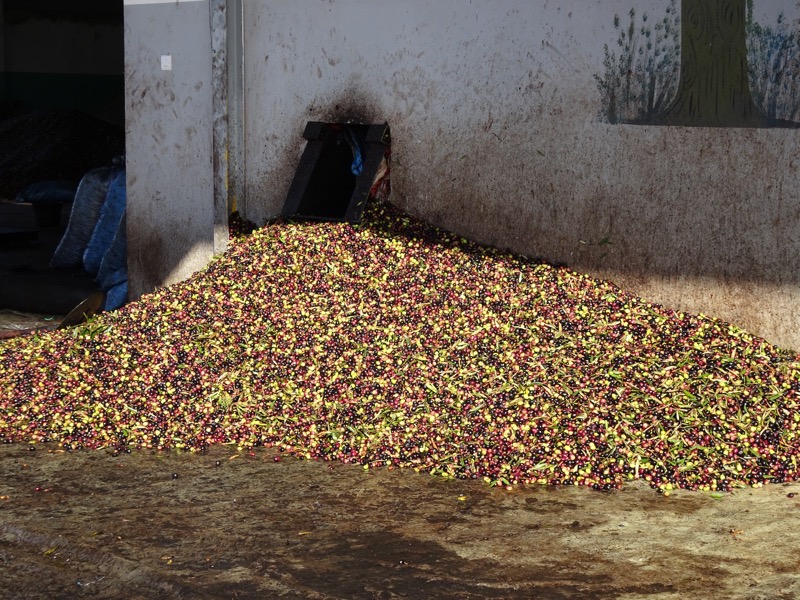 I actually disllike olives, which is weird for me as I usually love savoury and salty foods. The smell here was getting to me quite a bit. Bags of olives belonging to different farmers.
I actually disllike olives, which is weird for me as I usually love savoury and salty foods. The smell here was getting to me quite a bit. Bags of olives belonging to different farmers. A couple of the men who worked here – their clothes are soaked through with olive oil, their hands and faces black with oily gunk.
A couple of the men who worked here – their clothes are soaked through with olive oil, their hands and faces black with oily gunk. 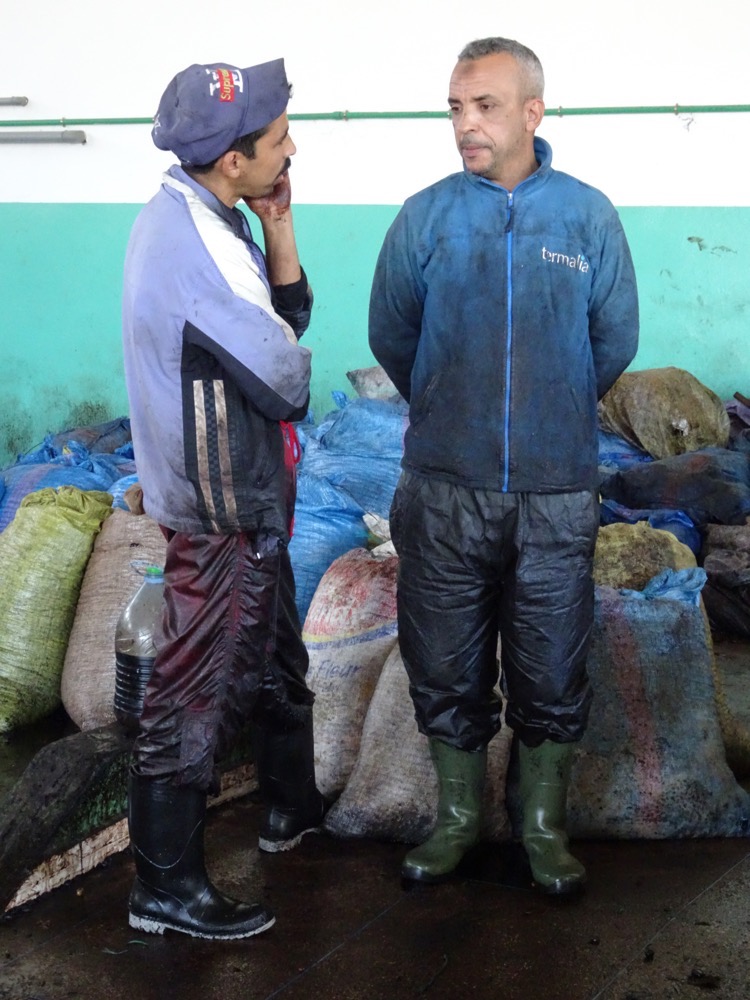 This must be one of the few largely automated processes we have seen in Morocco so far… until now, it seemed like nearly everything is done by hand.
This must be one of the few largely automated processes we have seen in Morocco so far… until now, it seemed like nearly everything is done by hand.
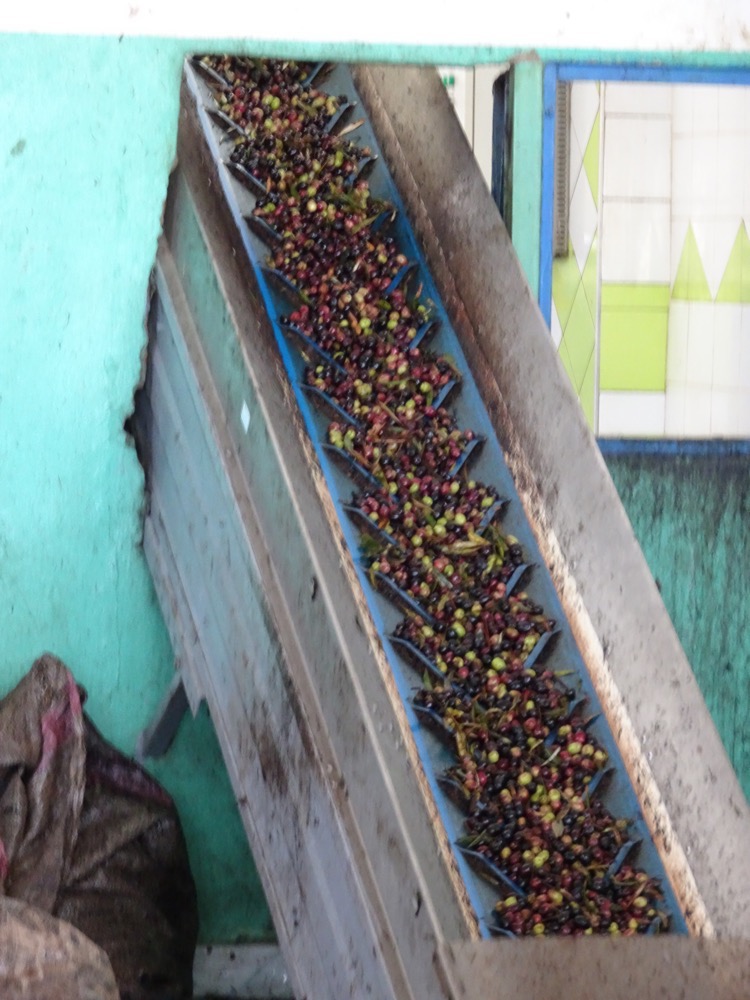

 The first press olive oil is thick and green.
The first press olive oil is thick and green.
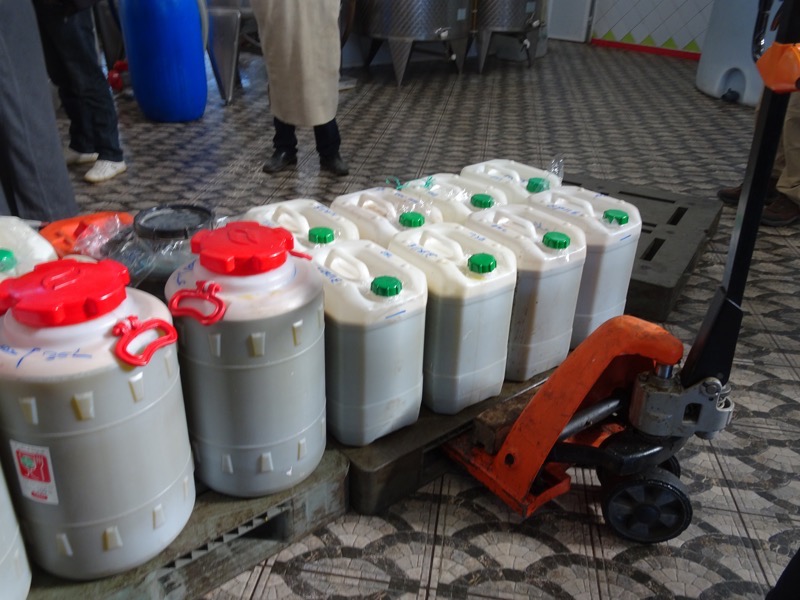 Everyone was offered a bit of bread to try it, along side other oils that had been processed for the second time and third time. I quite like my extra virgin olive oil, but not being a fan of things that actually taste like olives, I gave it a miss (good thing that turned out to be – at least two in our group said they paid for it as it went right through them and they were running for the bathroom a few hours later).
Everyone was offered a bit of bread to try it, along side other oils that had been processed for the second time and third time. I quite like my extra virgin olive oil, but not being a fan of things that actually taste like olives, I gave it a miss (good thing that turned out to be – at least two in our group said they paid for it as it went right through them and they were running for the bathroom a few hours later).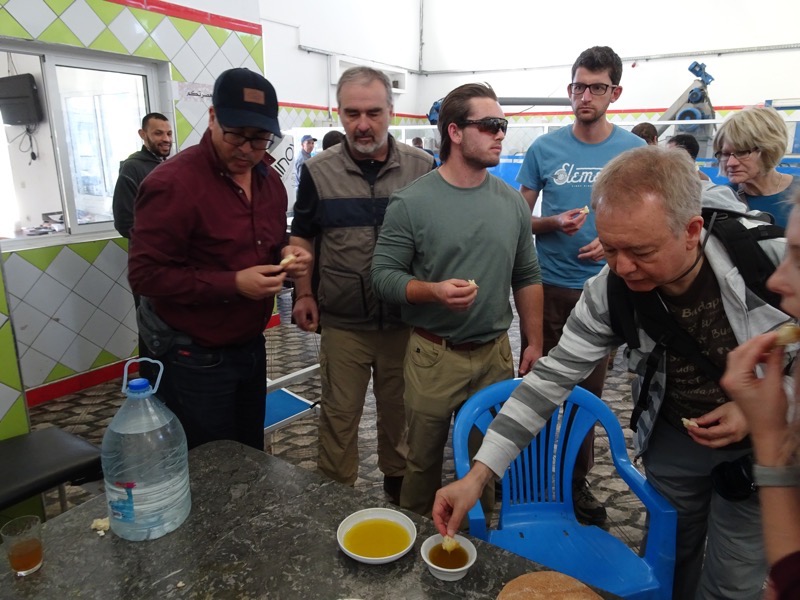
 Anyway, back on the bus and a few kilometers down the road we stopped for a picnic lunch. Before leaving Fez, we went to an enormous supermarket and all picked up some tidbits for lunch. We had some very tasty sandwiches and wraps with meats, cheeses, nuts, dates, figs etc. We even managed to buy some drinks so many had picked up some beers to have with lunch.
Anyway, back on the bus and a few kilometers down the road we stopped for a picnic lunch. Before leaving Fez, we went to an enormous supermarket and all picked up some tidbits for lunch. We had some very tasty sandwiches and wraps with meats, cheeses, nuts, dates, figs etc. We even managed to buy some drinks so many had picked up some beers to have with lunch. 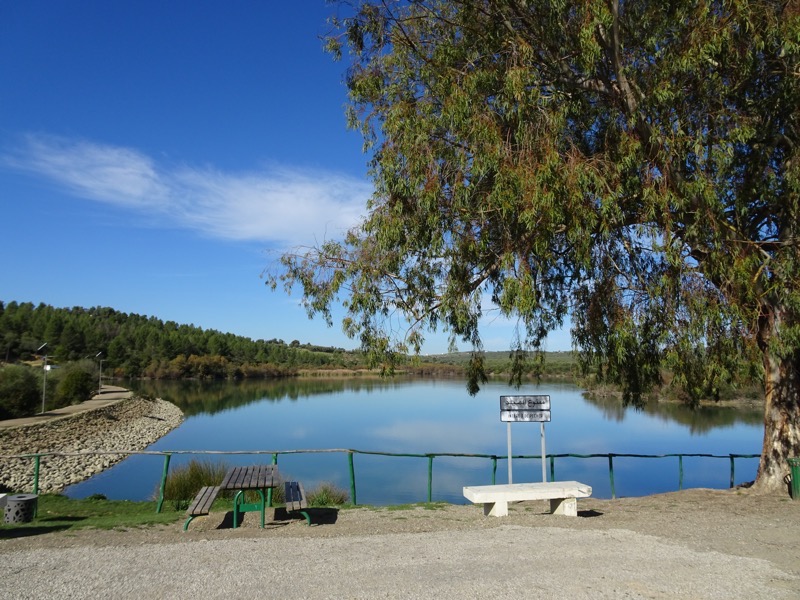 Hay stacks for the winter.
Hay stacks for the winter. 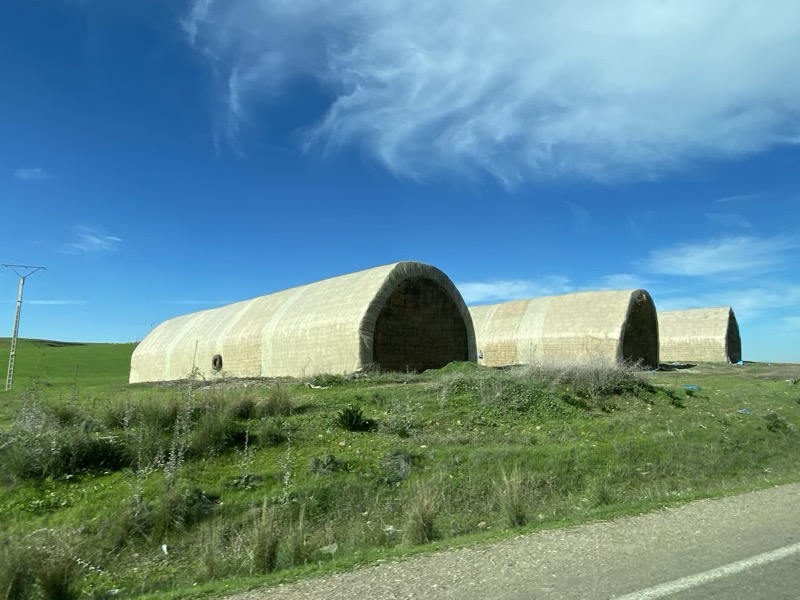 Everywhere, you could see enormous rows of prickly pear. They use it for a few different purposes – hedgerows are grown to make fencing to keep their animals in. The plant itself is eaten in some dishes, and the flowers are used for a natural dye. At home it’s a noxious weed.
Everywhere, you could see enormous rows of prickly pear. They use it for a few different purposes – hedgerows are grown to make fencing to keep their animals in. The plant itself is eaten in some dishes, and the flowers are used for a natural dye. At home it’s a noxious weed.  About another hour or so down the road and we arrived at Chefchaouen. Chefchaouen is nestled between two mountain peaks – the word itself actually means ‘two mountian horns’ – and is located at 560m above sealevel, about 70kms from the Mediterranean to the north and 130kms from the Atlantic to the west. From this lookout we could see some glimpses of the blue walls this city is so famous for.
About another hour or so down the road and we arrived at Chefchaouen. Chefchaouen is nestled between two mountain peaks – the word itself actually means ‘two mountian horns’ – and is located at 560m above sealevel, about 70kms from the Mediterranean to the north and 130kms from the Atlantic to the west. From this lookout we could see some glimpses of the blue walls this city is so famous for.
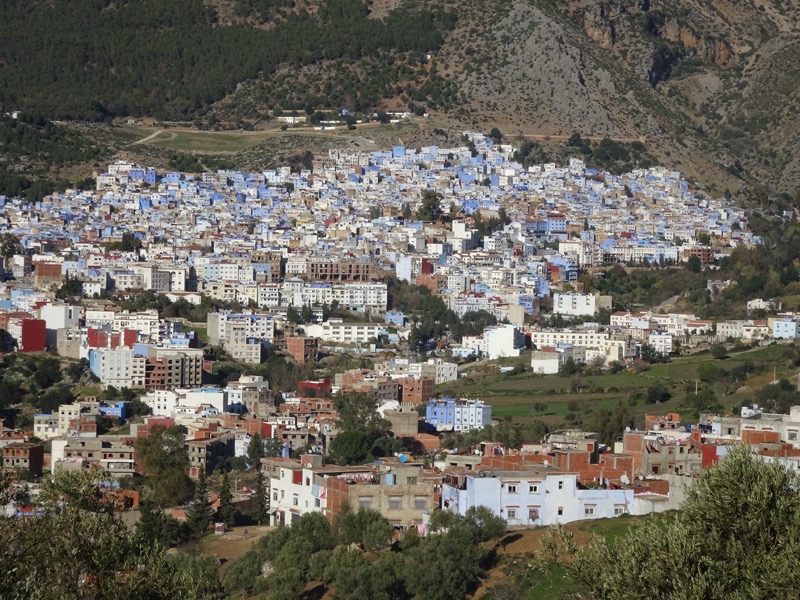 We arrived at our hotel Darechaouen and were greeted with cups of Moroccan mint tea and date cookies while they sorted the rooms out.
We arrived at our hotel Darechaouen and were greeted with cups of Moroccan mint tea and date cookies while they sorted the rooms out. 
We found ourselves being escorted to a lovely suite room with a large living room attached and a huge ensuite. Very nice!
After everyone had settled in, we went for a bit of an orientation walk around the town. Firstly up to see the mountain spring that feeds the town with fresh water.
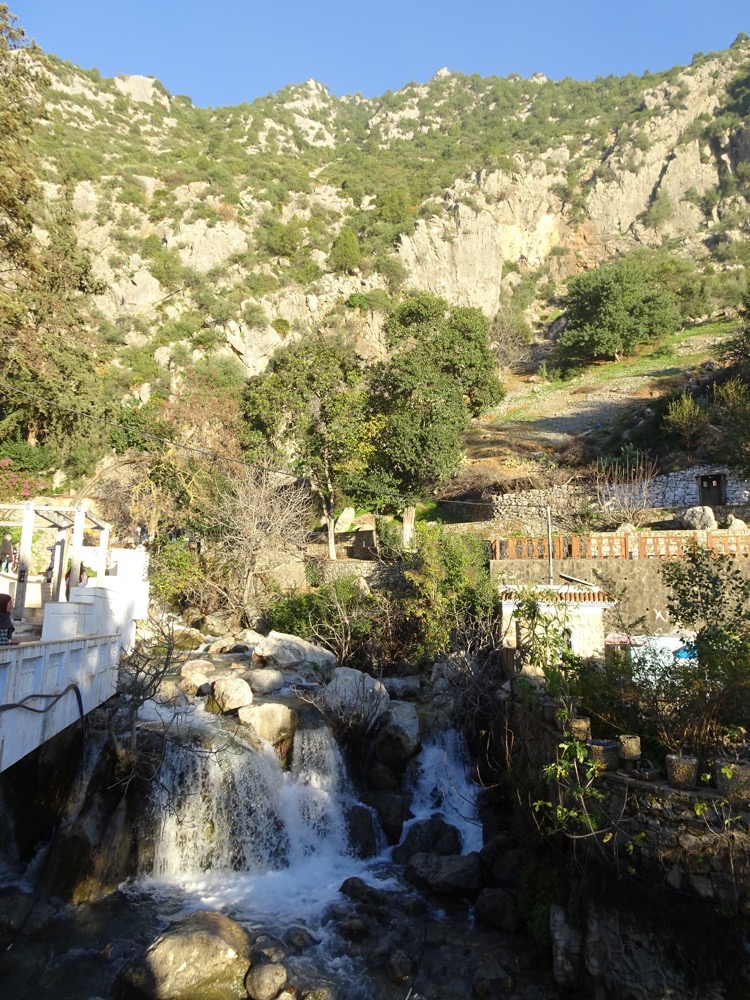
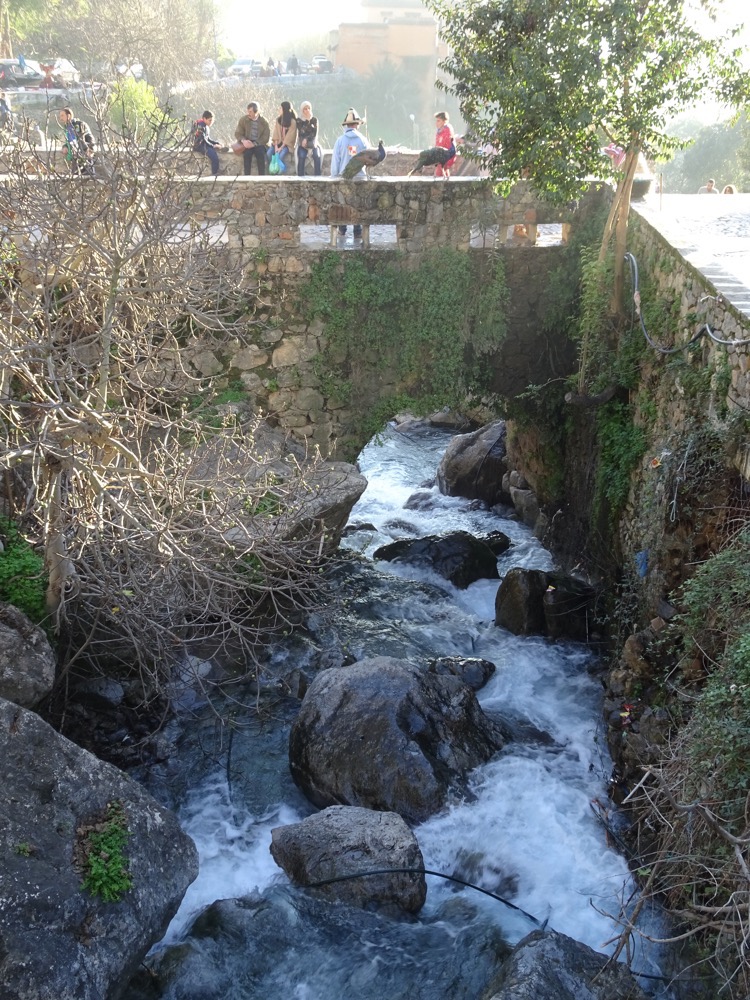 After the winter snow melts, this spring will have twice as much water pouring from it.
After the winter snow melts, this spring will have twice as much water pouring from it.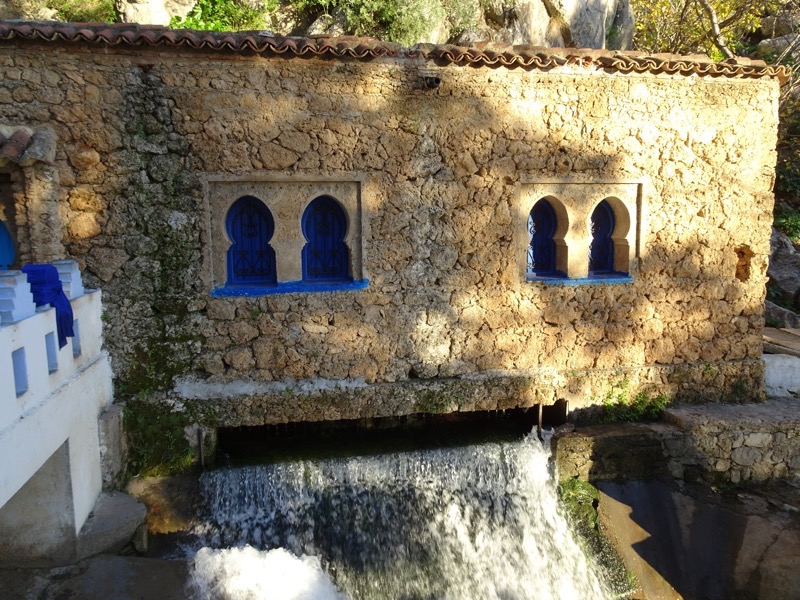
 Directly to the left of these four ladies was a bench with four men, presumably their husbands… “What you talking about?” – “Shopping” … “What you talking about?” – “Football”
Directly to the left of these four ladies was a bench with four men, presumably their husbands… “What you talking about?” – “Shopping” … “What you talking about?” – “Football”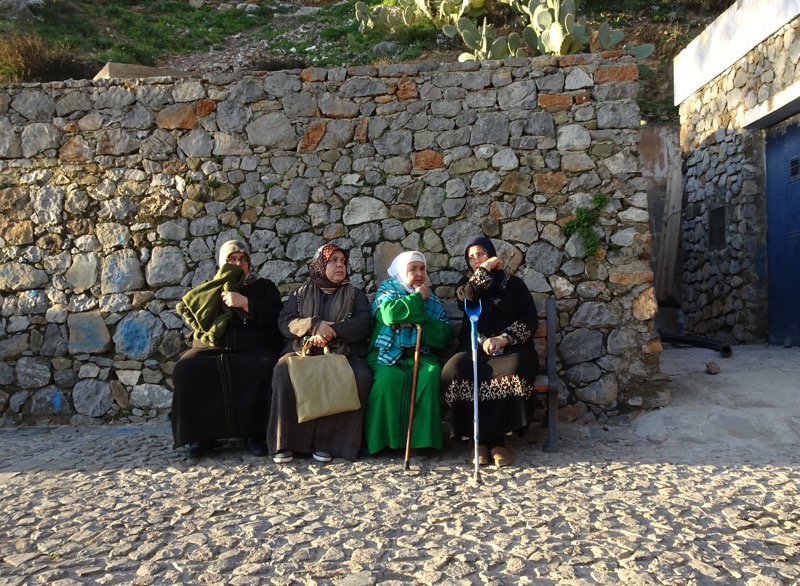
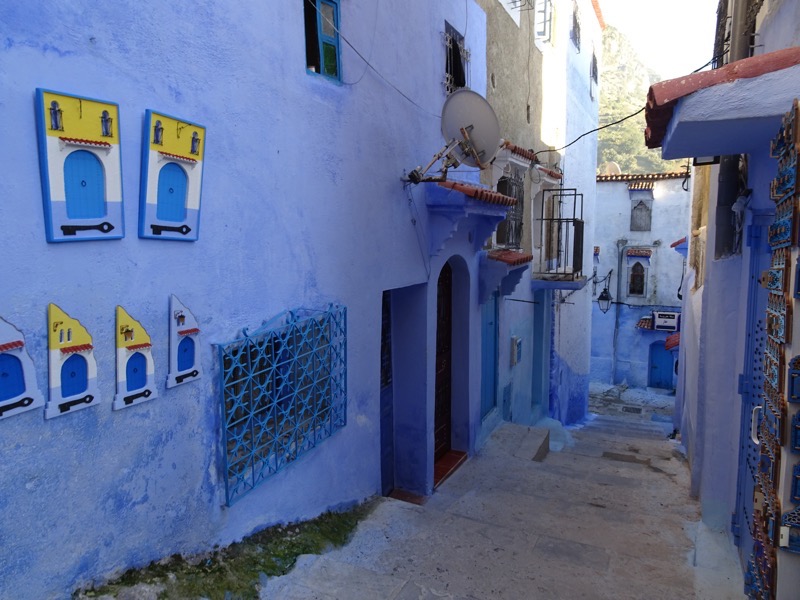
Chefchaouen was founded in 1471 as a small kasbah (fortress) to fight the Portuguese invasions of northern Morocco. Many local tribal people, Berbers and Ghomara peoples, as well as Moriscos and Jews, settled here after the Spanish Reconquista in the medieval period. In the early 20thC (c1920) the Spanish seized the city to form part of Spanish morocco. Spanish troops imprisoned local leaders in the kasbah for several years and there is a decidedly Spanish influence to a lot of the local architecture and food etc.
 The blue walls are what draws the tourists to town – it makes a stunning backdrop for photographs and is reminiscent of the blue-trimmed whitewashed walls of Santorini or Mykonos. No one is entirely sure why the walls are painted blue – there are several theories though. One popular theory is that the blue keeps the mosquitos away, another is that the Jews introduced the blue when they took refuge here from Hitler’s regime in the 1930s. Another is that the blue paint was brought down as leftover paint from what was used to paint fishing boats to the north. And yet another theory is that the blue symbolizes the sky and the heaven to serve as a reminder to lead a spiritual life. However, some locals apparently say that the town mandated walls were to be primarily painted blue simply to attract tourists at some point int he 1970s… which while far less whimsical, is probably far more likely.
The blue walls are what draws the tourists to town – it makes a stunning backdrop for photographs and is reminiscent of the blue-trimmed whitewashed walls of Santorini or Mykonos. No one is entirely sure why the walls are painted blue – there are several theories though. One popular theory is that the blue keeps the mosquitos away, another is that the Jews introduced the blue when they took refuge here from Hitler’s regime in the 1930s. Another is that the blue paint was brought down as leftover paint from what was used to paint fishing boats to the north. And yet another theory is that the blue symbolizes the sky and the heaven to serve as a reminder to lead a spiritual life. However, some locals apparently say that the town mandated walls were to be primarily painted blue simply to attract tourists at some point int he 1970s… which while far less whimsical, is probably far more likely.
 And it works. Chefchaouen is a very popular tourist destination, partly due to its proximity to Tangier. There are over two hundred riad and hotels to cater for the influx of tourists – once largely catering to the European tourists (lots of Spanish arrive here at Easter and Christmas holidays), but now more commonly the Chinese tourists are here for their photos too.
And it works. Chefchaouen is a very popular tourist destination, partly due to its proximity to Tangier. There are over two hundred riad and hotels to cater for the influx of tourists – once largely catering to the European tourists (lots of Spanish arrive here at Easter and Christmas holidays), but now more commonly the Chinese tourists are here for their photos too.
The region is also known for its native handicrafts that are not seen anywhere else in Morocco, particularly Berber style woollen garments, rugs and woven blankets. 
 Want to see my scoot?!
Want to see my scoot?! The surrounding countryside is well known as a prolific source of ‘kief’ – marijuana, and as we walked the town you would semiregularly get a strong whiff of pot as you rounded a corner or walked past a shop.
The surrounding countryside is well known as a prolific source of ‘kief’ – marijuana, and as we walked the town you would semiregularly get a strong whiff of pot as you rounded a corner or walked past a shop. There are public fountains dotting the town that are gravity fed directly from the mountain spring – hundreds of years old, they have seen a lot of use.
There are public fountains dotting the town that are gravity fed directly from the mountain spring – hundreds of years old, they have seen a lot of use. There are quaint little alleyways in every direction, most of them steep and because of the fountains located around the place, most of the walkways were slightly wet and rather slippery.
There are quaint little alleyways in every direction, most of them steep and because of the fountains located around the place, most of the walkways were slightly wet and rather slippery. Chefchaouen is also knowns for it’s remarkably varied and popular blue doors… so many gates and doors everywhere – some simple, some elaborately painted, some enormous and some so small I have to duck to go in.
Chefchaouen is also knowns for it’s remarkably varied and popular blue doors… so many gates and doors everywhere – some simple, some elaborately painted, some enormous and some so small I have to duck to go in. This (below) is one of the most famous photo spots in the city… Samirr warned us that if there were Chinese tourists here, we would ‘have to come back next year’ rather than wait for them to finish taking their photos. The locals are completely over the habit of Chinese tourists to stand in front of any famous object and take fifty photos of themselves in a myriad of very posed positions (tbh, so am I – Iceland last year was a real test of patience on that front).
This (below) is one of the most famous photo spots in the city… Samirr warned us that if there were Chinese tourists here, we would ‘have to come back next year’ rather than wait for them to finish taking their photos. The locals are completely over the habit of Chinese tourists to stand in front of any famous object and take fifty photos of themselves in a myriad of very posed positions (tbh, so am I – Iceland last year was a real test of patience on that front).
When we arrived here of course there were a handful of Chinese tourists hogging ‘the spot’ for their selfies and posing away for their friends with the camera… as soon as one moves out of the way, another will quickly jump in. Samirr’s shoulders slumped and he said, ‘I guess we have to come back next year’. Instead, as one (totally overdressed Chinese lady) was moving out of shot and another was about to move in, I very loudly and firmly said to their group ‘Thank you! Thank you! No people for a moment please!’ and unexpectedly, it worked! They all held back while our group took a few photographs of the street with no people. 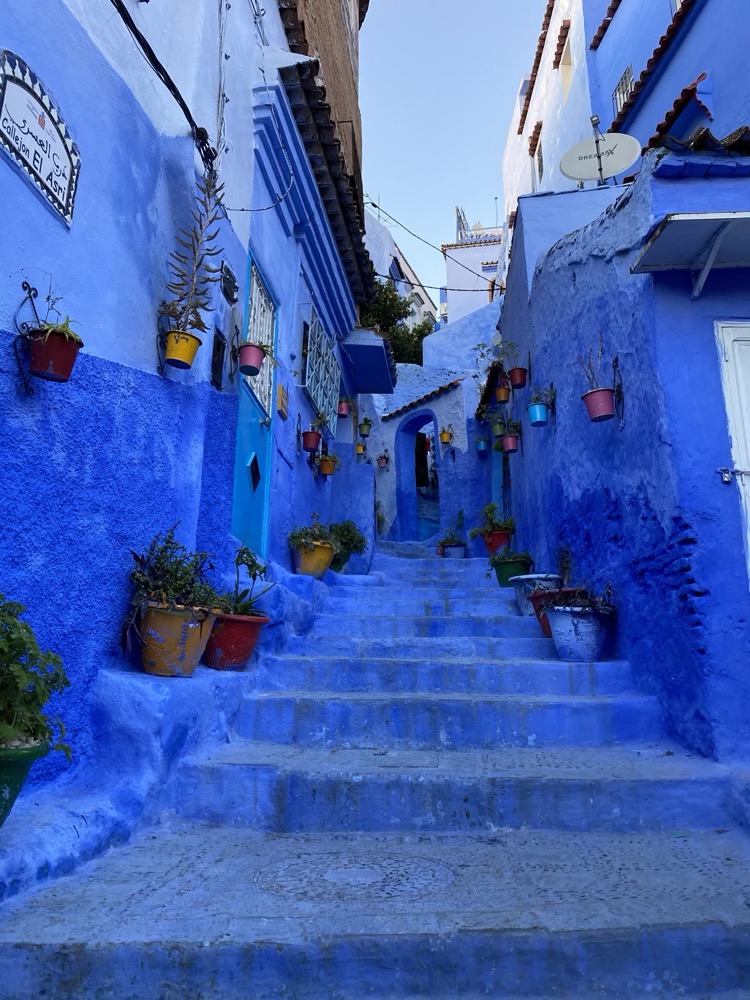 Samirr was impressed at my crowd management skills, our small tour group was pleased to have their chance at photos sans Chinese tourists, and I was simply stunned at the amazing beautiful blue colours of the steps on this tiny little street that attracts people from all over the world.
Samirr was impressed at my crowd management skills, our small tour group was pleased to have their chance at photos sans Chinese tourists, and I was simply stunned at the amazing beautiful blue colours of the steps on this tiny little street that attracts people from all over the world.
As we walked away from the area, everyone was thanking me for clearing the street, but after last year in Iceland where we would stand around patiently waiting for 10 to 15 minutes or longer, waiting for self-absorbed arseholes to get out of the way – I give up. You obviously need to speak up or you just end up wasting time or missing out… patented Mommy Voice for the win.
A little futher we came to an area of town selling pigments for the local craftsmen. 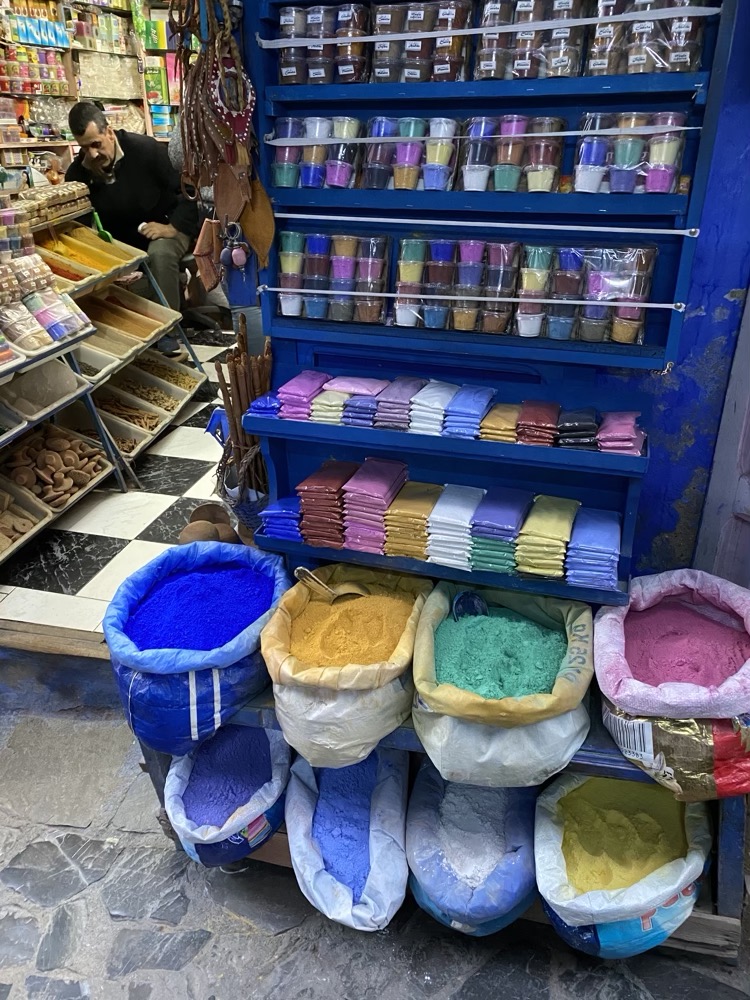

 I know it looks like the town is nearly empty in most of these photos – but this is just my judicious sense of timing. Pick a spot and wait for the person to move right out of frame and *click* before someone moves into the left of frame. But trust me, there were plenty of people around and the medina only became busier as the sun went down and the locals came to town for the restaurants and clubs.
I know it looks like the town is nearly empty in most of these photos – but this is just my judicious sense of timing. Pick a spot and wait for the person to move right out of frame and *click* before someone moves into the left of frame. But trust me, there were plenty of people around and the medina only became busier as the sun went down and the locals came to town for the restaurants and clubs.
The original 15thC kasbah which we may go visit tomorrow… The town’s main square, which is pretty much at the bottom of the steep medina.
The town’s main square, which is pretty much at the bottom of the steep medina.  Still.. there were further little alleyways winding further down the mountain and we were diving back into them to find a Berber carpet shop.
Still.. there were further little alleyways winding further down the mountain and we were diving back into them to find a Berber carpet shop.  As tradition dictates, one must go carpet/rug shopping when in Turkey or Pakistan or India or Morocco and well, nearly everywhere from North Africa to the Subcontinent!
As tradition dictates, one must go carpet/rug shopping when in Turkey or Pakistan or India or Morocco and well, nearly everywhere from North Africa to the Subcontinent!
 Abdullah, our host offered us all sweet Moroccan mint tea… very sweet this time and quite refreshing. This is also part of the tradition, coming right before the selling! In Turkey, I think they have much more success with the selling part, as they often ply customers with beer and raki instead. Here, have a buzz, buy a rug!
Abdullah, our host offered us all sweet Moroccan mint tea… very sweet this time and quite refreshing. This is also part of the tradition, coming right before the selling! In Turkey, I think they have much more success with the selling part, as they often ply customers with beer and raki instead. Here, have a buzz, buy a rug!  The group waiting for the rugs to start falling.
The group waiting for the rugs to start falling.
 And so they did… Abdullah*, threw down about fifty rugs in total, all of them locally made by Berber tribes, and in a wide variety of colours and sizes. These rugs are unlike any I’ve seen before, predominantly kilim style and most of them asymmetrical in design – which makes me twitch like all giddyup. So I was pretty safe from any unplanned rug purchases.
And so they did… Abdullah*, threw down about fifty rugs in total, all of them locally made by Berber tribes, and in a wide variety of colours and sizes. These rugs are unlike any I’ve seen before, predominantly kilim style and most of them asymmetrical in design – which makes me twitch like all giddyup. So I was pretty safe from any unplanned rug purchases.
(*We were fairly confident that Abdullah was stoned off his gourd which was vaguely amusing.) Anyway after our rug shopping experience, where no one found anything they liked, we went to a restaurnt called, Restaurant Bab Ssour, for a lovely rooftop dining and some delicious local tagine dishes.
Anyway after our rug shopping experience, where no one found anything they liked, we went to a restaurnt called, Restaurant Bab Ssour, for a lovely rooftop dining and some delicious local tagine dishes.  The view across the medina from the rooftop terrace.
The view across the medina from the rooftop terrace.
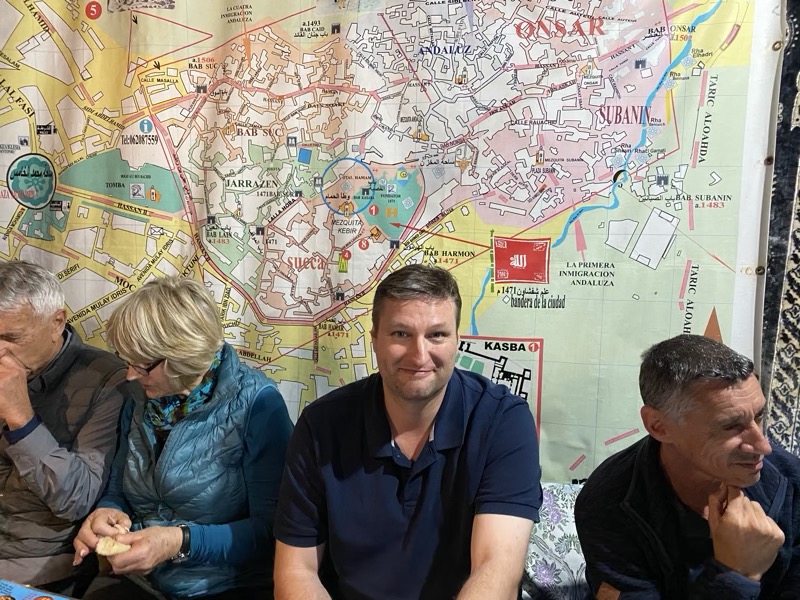 Goat cheese is a speciality local dish, served with balsamic. It was really good and had a smooth creamy texture.
Goat cheese is a speciality local dish, served with balsamic. It was really good and had a smooth creamy texture.
 Goat tagine with plums! The meat was just falling off the bone and absolutely delicious.
Goat tagine with plums! The meat was just falling off the bone and absolutely delicious.
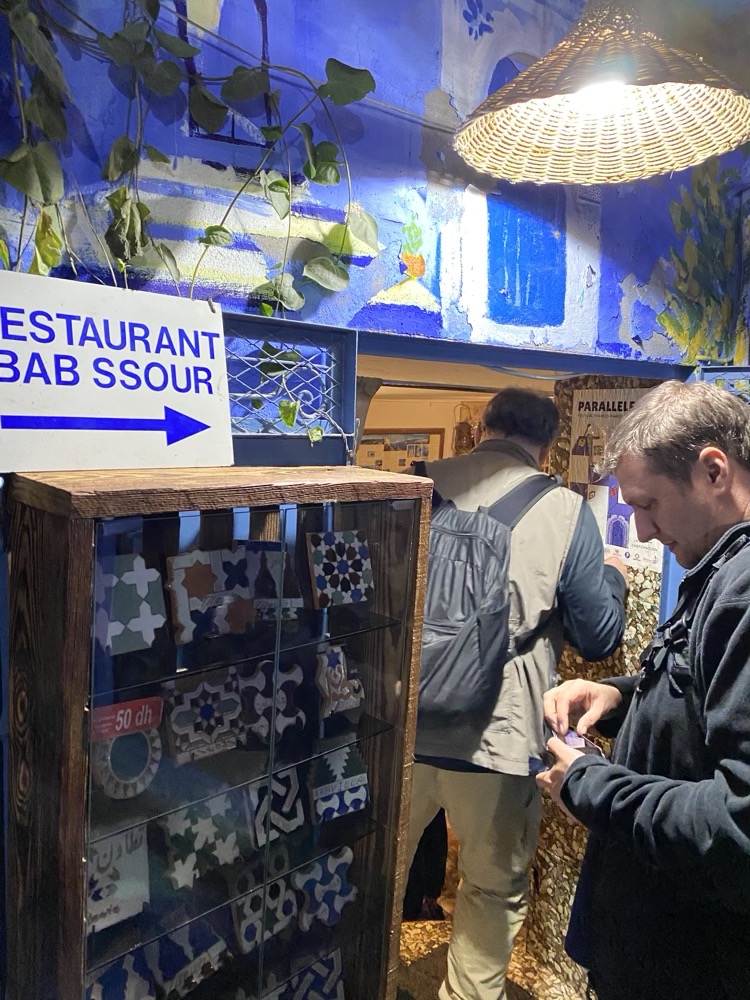 After our long day of driving followed by what was supposed to be a short orientation walk (6kms), we head back to the hotel for a vodka tonic and crashed in our big luxurious bed.
After our long day of driving followed by what was supposed to be a short orientation walk (6kms), we head back to the hotel for a vodka tonic and crashed in our big luxurious bed.
